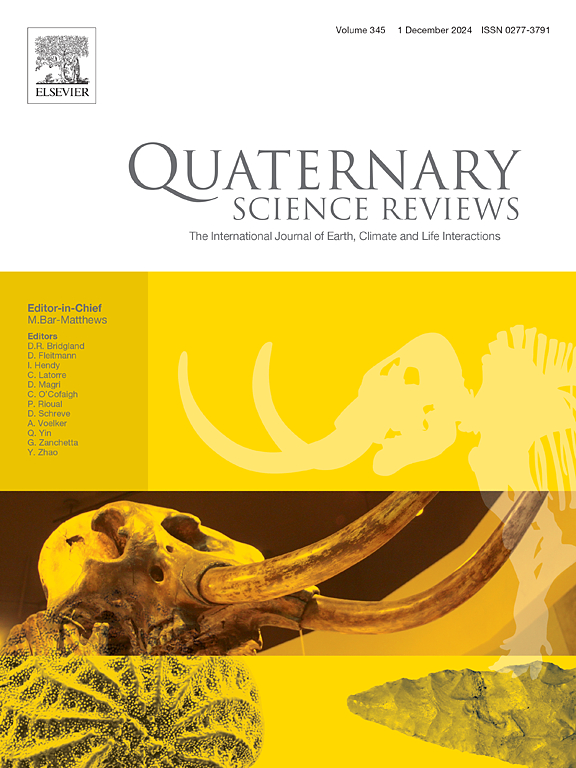Reconstructing the magnitudes of Holocene extraordinary floods in the upper Huai River, China
IF 3.2
1区 地球科学
Q1 GEOGRAPHY, PHYSICAL
引用次数: 0
Abstract
Palaeoflood natural archives provide vital insights for reconstructing extraordinary flood magnitudes and understanding climate change. Palaeohydrological investigations were conducted in the upper Huai River, North China Plain. A Holocene loess-paleosol sedimentary profile containing six palaeoflood slackwater deposits (SWD, SWD6–SWD1) was identified in the Luzhuang reach of the upper Huai River, where the Maoji River (a tributary of the Huai River) enters the Huai River. Sediment samples were collected for physicochemical analysis and optically stimulated luminescence (OSL) dating, respectively. The results revealed that the sedimentary accumulation consists of modern soil (MS), paleosol (S0), aeolian loess (L0), and transitional loess (Lt) sediments were predominantly silt (>50 %), whereas SWDs were mainly sand (>60 %). Geochemically, the elemental composition of SWDs was similar to that of MS, S0, and L0 sediments, but distinct from Lt. The MS, L0, S0, and Lt sediments demonstrated moderate weathering that was more pronounced than that of SWDs. Using OSL dating and stratigraphic chronological frameworks, six extraordinary palaeoflood events have been identified in the Luzhuang reach of the upper Huai River since approximately 8.5 ka in the Holocene. The palaeoflood magnitudes were reconstructed using the HEC-RAS hydraulic model, with six reconstructed palaeoflood peak discharges ranging from 9260 to 17,810 m3/s. Moreover, the sensitivity of the peak discharge calculated using the HEC-RAS model to the roughness coefficient was low, with a relative error of only −8.7 %–2.9 %. These extraordinary palaeoflood events corresponded to periods of climate change and instability, closely related to the El Niño-Southern Oscillation (ENSO). This study provides valuable insights into the effects of global change on regional hydrological systems.
淮河上游全新世特大洪水震级重建
古洪水自然档案为重建特大洪水震级和理解气候变化提供了重要的见解。在华北平原淮河上游进行了古水文调查。在淮河上游毛吉河入海口的鲁庄河段,发现了一个包含6个古洪水平流沉积(SWD, SWD6-SWD1)的全新世黄土-古土壤沉积剖面。采集沉积物样品分别进行物化分析和光激发光测年。结果表明:沉积堆积物由现代土壤(MS)、古土壤(S0)、风成黄土(L0)和过渡性黄土(Lt)沉积物组成,以粉砂为主(> 50%),而SWDs以砂土为主(> 60%)。在地球化学上,SWDs的元素组成与MS、L0、L0沉积层相似,但与Lt沉积层不同,MS、L0、S0、Lt沉积层表现出较明显的中度风化作用。利用OSL测年和地层年代学框架,确定了全新世约8.5 ka以来淮河上游鲁庄河段发生的6次特大古洪水事件。利用HEC-RAS水力模型重建了古洪水震级,重建了6次古洪水洪峰流量,范围为9260 ~ 17810 m3/s。此外,使用HEC-RAS模型计算的峰值放电对粗糙度系数的灵敏度较低,相对误差仅为- 8.7% - 2.9%。这些非同寻常的古洪水事件与气候变化和不稳定时期相对应,与厄尔尼诺Niño-Southern涛动(ENSO)密切相关。这项研究为全球变化对区域水文系统的影响提供了有价值的见解。
本文章由计算机程序翻译,如有差异,请以英文原文为准。
求助全文
约1分钟内获得全文
求助全文
来源期刊

Quaternary Science Reviews
地学-地球科学综合
CiteScore
7.50
自引率
15.00%
发文量
388
审稿时长
3 months
期刊介绍:
Quaternary Science Reviews caters for all aspects of Quaternary science, and includes, for example, geology, geomorphology, geography, archaeology, soil science, palaeobotany, palaeontology, palaeoclimatology and the full range of applicable dating methods. The dividing line between what constitutes the review paper and one which contains new original data is not easy to establish, so QSR also publishes papers with new data especially if these perform a review function. All the Quaternary sciences are changing rapidly and subject to re-evaluation as the pace of discovery quickens; thus the diverse but comprehensive role of Quaternary Science Reviews keeps readers abreast of the wider issues relating to new developments in the field.
 求助内容:
求助内容: 应助结果提醒方式:
应助结果提醒方式:


